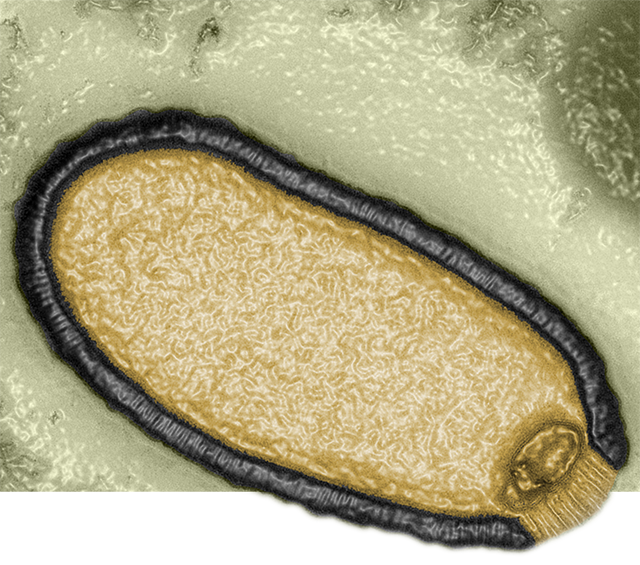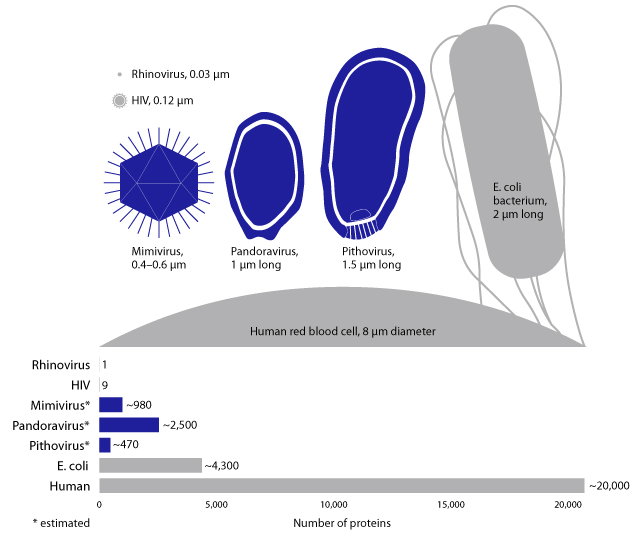Hints of Life’s Start Found in a Giant Virus

Chantal Abergel and Jean-Michel Claverie were used to finding strange viruses. The married virologists at Aix-Marseille University had made a career of it. But pithovirus, which they discovered in 2013 in a sample of Siberian dirt that had been frozen for more than 30,000 years, was more bizarre than the pair had ever imagined a virus could be.
In the world of microbes, viruses are small — notoriously small. Pithovirus is not. The largest virus ever discovered, pithovirus is more massive than even some bacteria. Most viruses copy themselves by hijacking their host’s molecular machinery. But pithovirus is much more independent, possessing some replication machinery of its own. Pithovirus’s relatively large number of genes also differentiated it from other viruses, which are often genetically simple — the smallest have a mere four genes. Pithovirus has around 500 genes, and some are used for complex tasks such as making proteins and repairing and replicating DNA. “It was so different from what we were taught about viruses,” Abergel said.
The stunning find, first revealed (opens a new tab) in March, isn’t just expanding scientists’ notions of what a virus can be. It is reframing the debate over the origins of life.
Scientists have traditionally thought that viruses were relative latecomers to the evolutionary stage, emerging after the appearance of cells. “They rely on cellular machinery to help with their replication, so they need to have some sort of primitive cell to make use of that machinery,” said Jack Szostak (opens a new tab), a biochemist at Harvard University and a Nobel laureate. In other words, viruses mooch off cells, so without cells, viruses can’t exist.
But some scientists say the discovery of giant viruses could turn that view of life on its head. They propose that the ancestors of modern viruses, far from being evolutionary laggards, might have provided the raw material for the development of cellular life and helped drive its diversification into the varied organisms that fill every corner of the planet.
“These giant viruses are the perfect example of how a world of simple viruslike elements could evolve into something much more complex,” said Eugene Koonin (opens a new tab), a computational biologist at the National Institutes of Health. Koonin described his theory for a viral origin of life in a paper published (opens a new tab) in June in the journal Microbiology and Molecular Biology Reviews. He and others are accumulating evidence that viruslike elements spurred several of the most important stages in the emergence of life: the evolution of DNA, the formation of the first cells, and life’s split into three domains — Archaea, bacteria, and eukaryotes. Archaea and bacteria are all unicellular organisms, and eukaryotes emerged after an ancient fusion event between an archaeon and a bacterium.
The predominant theories for the origin of viruses propose that they emerged either from a type of degenerate cell that had lost the ability to replicate on its own or from genes that had escaped their cellular confines.
Giant viruses, first described in 2003, began to change that line of thinking for some scientists. These novel entities represented an entirely new kind of virus. Indeed, the first specimen — isolated from an amoeba living in a cooling tower in England — was so odd that it took scientists years to understand what they had. They first assumed the amorphous blob was a bacterium. It was roughly the same size as other bacteria and turned a brilliant indigo when stained with a chemical that adheres only to some bacteria. Try as they might, however, even a team of crack British microbiologists couldn’t grow the organism in the lab. Because many types of bacteria are difficult, if not impossible, to grow in the lab, the scientists didn’t think much of it and put the sample in the freezer.
Nearly a decade later, a curious graduate student in England took samples of the organism to Didier Raoult, a microbiologist in France who specialized in difficult-to-grow bacteria. He looked at the blob, only this time with a powerful electron microscope. As luck would have it, Abergel and Claverie were collaborating with him on another project. They immediately recognized the organism’s viruslike shape — imagine a 20-sided die, with each face a triangle — even though the specimen was several times larger than any virus either had seen.
When Abergel and Claverie looked at the virus’s genome, they found it contained nearly 1,000 genes — as many as some bacteria. The scientists named it mimivirus, for MImicking MIcrobe virus, because amoebae appear to mistake it for their typical bacterial meal.
Abergel and Claverie suspected that giant viruses abound in the natural world but go undetected because of their size. They took samples of amoebae-filled water from nearly every locale they visited. In two samples — one from a stream in Melbourne, Australia, and one taken off the coast of Chile — they found an even bigger virus growing in amoebae, which they named pandoravirus and described in a study (opens a new tab) in the journal Science last year. “We repeated every experiment 10 times because this virus was so weird,” Abergel said. “We kept thinking we had made a mistake.”
With a staggeringly high number of genes, approximately 2,500, pandoravirus seemed to herald an entirely new class of viral life. “More than 90 percent of its genes did not resemble anything else found on Earth,” Abergel said. “We were opening Pandora’s box, and we had no idea what might be inside.”
Then, several months ago, they found pithovirus, which dwarfs even pandoravirus in size and possesses genes equally as strange. These bizarre genes immediately led scientists to speculate on the origin of giant viruses. Since pithoviruses genes were so different from anything else scientists had seen, it seemed possible that the ancestors of giant viruses had evolved early in life’s history. This idea, however, conflicted with the generally accepted view that viruses didn’t evolve until much later. Giant viruses provide the perfect opportunity to study how viruses evolved, since they are only distantly related to other viruses and afford an as-yet unseen perspective on virus evolution. But when exactly did viruses emerge — before or after the development of cellular life?
Koonin is firmly in the “before” camp. According to his theory, dubbed the Virus World, the ancestors of modern viruses emerged when all life was still a floating stew of genetic information, amino acids and lipids. The earliest pieces of genetic material were likely short pieces of RNA with relatively few genes that often parasitized other floating bits of genetic material to make copies of themselves. These naked pieces of genetic information swapped genes at a primeval genetic flea market, appropriating hand-me-downs from other elements and discarding genes that were no longer needed.
Over time, Koonin argues, the parasitic genetic elements remained unable to replicate on their own and evolved into modern-day viruses that mooch off their cellular hosts. The genes they parasitized began to evolve different types of genetic information and other barriers to protect themselves from the genetic freeloaders, which ultimately evolved into cells.
The Virus World Theory is closely related to the RNA World Theory, which says life first evolved as small pieces of RNA that slowly developed into complex DNA-carrying organisms. The Virus World Theory agrees that life’s genetic material began as RNA. But it differs by arguing that the ancestors of viruses evolved before cells.
Supporters point to a few lines of evidence. First, the diversity of viruses far exceeds that found in cellular life. “Where diversity lies, origin lies,” said Valerian Dolja (opens a new tab), a virologist and plant cell biologist at Oregon State University who collaborates with Koonin. According to this perspective, if viruses developed from cells, they should be less diverse because cells would contain the entire range of genes available to viruses. It’s a recurring theme in evolutionary biology: One of the reasons we know humans originated in Africa is that genetic diversity among residents of that continent is much greater than it is anywhere else. If this pattern of diversity is true for humans, Dolja said, there’s no reason it can’t also be true for viruses.
Viruses are also more diverse when it comes to reproduction. “Cells only have two main ways of replicating their DNA,” said Patrick Forterre (opens a new tab), a virologist at Paris-Sud University. “One is found in bacteria, the other in Archaea and eukaryotes.” Viruses, on the other hand, have many more methods at their disposal, he said.
Forterre suggests that viruses evolved after primitive cells but before modern cells. Some of the viruses that infect the three different domains of life share several of the same proteins, suggesting that they may have evolved before life diverged into these three branches. Forterre has yet to identify any of these proteins in cellular life, except in a snippet of DNA that was clearly the result of the insertion of viral genes. “Viruses had to exist before the last universal common ancestor of all life on Earth,” Forterre said.
Alive or Not?
Giant viruses have further blurred the definition of what it means to be alive. According to the standard definition, traditional viruses are not alive because they lack the machinery to replicate their genes and must steal those found in their cellular hosts. But giant viruses seem to lie somewhere between bacterium and virus — alive and not. They have some genes involved in replication, which indicates that they may have once been free-living organisms that devolved into viruses. Some researchers say that means they deserve their own branch on the tree of life, creating a fourth domain that would leave the other three — Archaea, bacteria and eukaryotes— largely intact. Also supporting the idea of a giant viral branch is their genetic weirdness: Giant viruses have unusual genes that aren’t found on other branches of the tree.
Despite their unusual genes, giant viruses have been grouped into a larger family of viruses known as the nucleocytoplasmic large DNA viruses, which includes smallpox. Giant viruses are much more complex than smallpox, so scientists initially thought they evolved later than their more traditional viral cousins. But more recent work indicates that these viruses also evolved very early in the history of life. Gustavo Caetano-Anolles (opens a new tab), a bioinformatics specialist at the University of Illinois, Urbana-Champaign, traced the evolutionary history of proteins found in several giant viruses in a 2012 study (opens a new tab) in the journal BMC Evolutionary Biology. His work shows that these viruses “represent a form of life that either predated or coexisted with the last universal common ancestor,” the most recent organism from which all other organisms on Earth are descended. If giant viruses are as old as Caetano-Anolles’ calculated, the implications are staggering. It means that a giant virus or one of its ancestors existed before other types of life and may have played a major role in shaping life as we know it. This could mean that viruses are one of the dominant evolutionary forces on this planet and that each organism has a deep, viral past.

Szostak agrees with Koonin and others that viruses have been a powerful evolutionary force and that they evolved earlier than scientists previously thought. However, he distinguishes between parasitic genetic elements (small pieces of genetic material that use other pieces of genetic material to make copies of themselves), which he agrees were likely present before the development of cells, and true viruses, which can’t exist without cells.
“Whenever you mix a bunch of small RNA molecules together, you get a bunch of parasitic sequences that aren’t good at anything except making copies of themselves faster than anything else,” Szostak said. For these sequences to become similar to modern viruses, they need to parasitize a living cell, not just another strand of RNA.
Dolja disagrees, saying that cells could not have evolved without viruses. “In order to move from RNA to DNA, you need an enzyme called reverse transcriptase,” Dolja said. “It’s only found in viruses like HIV, not in cells. So how could cells begin to use DNA without the help of a virus?”
Abergel and Claverie, however, believe that viruses emerged from cells. While Forterre and collaborators contend that the unique genes found in giant viruses are a sign that they evolved before modern cells, Abergel and Claverie have a different explanation: Giant viruses may have evolved from a line of cells that is now extinct. According to this theory, the ancestor of giant viruses lost its ability to replicate as an independent life form and was forced to rely on other cells to copy its DNA. Pieces of these ancient cells’ genes survive in modern mimivirus, pandoravirus, and pithovirus, which would explain the unique genes found in this group. “Life didn’t have one single ancestor,” Claverie said. “There were a lot of cell-like organisms that were all competing, and there was one winner, which formed the basis for life as we know it today.”
It’s unlikely the debate over when and how viruses first evolved will ever be settled — that’s the nature of trying to answer a question whose history has faded with time. But Abergel and Claverie continue to believe that giant viruses will be key to any answers that emerge. The pair hunts for even larger, stranger iterations, which they hope will reveal not only the evolution of giant viruses, but perhaps of all viruses. “Everywhere we look, we find giant viruses,” Claverie said. “Either we’re brilliant or these things are everywhere.”
Corrected on July 11, 2014: An earlier version of this article incorrectly described a characteristic virus shape as a 20-sided die, with each face a hexagon. Each face of the die is a triangle, and the shape looks like a hexagon in two dimensions.
This article was reprinted on NationalGeographic.com (opens a new tab).



